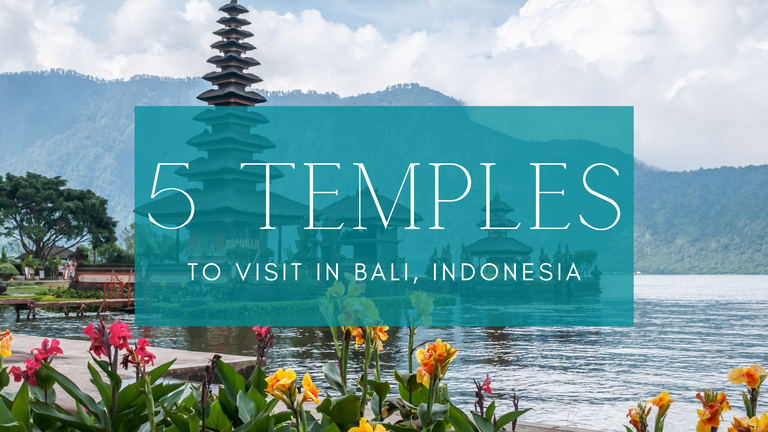
There are over 10 000 Hinduist temples in Bali. For quite a small island that Bali is, that is an unbelievable number. How to know which one to visit?
Well, the first criterion is that you are not allowed into the majority of them unless you are a Hinduist yourself. That narrows the options, but there are still too many to choose from. That’s why I created this list of 5 temples that are distinctive and totally worth visiting.
1. Pura Pasar Agung
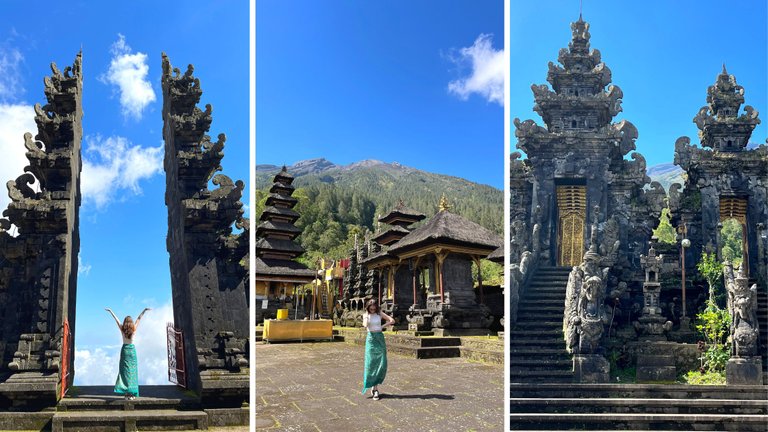
Unlike the popular Pura Lempuyang, where you wait literally for HOURS for THAT famous picture (you know, the gate, the water, and Mount Agung in the background), Pura Pasar is quiet, secluded, and beautiful.
The temple is located on the steep slopes of Mount Agung, Bali’s tallest and most active volcano, at 1600 meters above sea level. The interior isn’t that interesting, but the surroundings are breathtaking. That is when the temple isn’t hiding in the clouds (which happens quite often).
For a higher chance of seeing the beauty around, I recommend coming early in the morning – there are usually fewer clouds. If you’re lucky, you can admire the top of the majestic Mount Agung from the temple itself and take a beautiful picture at the „gate of heaven“. You can try to guess why it is called that 😉
To enter the temple, you should wear a sarong – the local ceremonial wide scarf tied around your legs. There are two ways to tie it, depending on your sex, but they are quite easily mastered. The locals are also always eager to help tie it up. Usually, you can borrow sarongs at temples, or you can buy your own at a local market.
2. Pura Tirta Empul

This temple is popular among both locals and tourists. Located in central Bali, it offers quite easy access from everywhere and is the only place where both Hinduists and non-Hinduist can come together in one cleansing ceremony.
Tirta Empul is known for its holy water that springs inside the very temple – that’s also why the spring is very cold (at least for Bali). It’s considered one of the most important temples in Bali, and you’re required to wear a sarong here as well. If you plan on joining the cleansing ceremony, you need to borrow a special ceremonial sarong which is green and tied with a red ribbon.
Then, you join people in the center of the temple and cleanse yourself under the majority of water tubes. However, not all of them are for you; one or two are always considered for the dead. But don’t worry, you’ll know which ones are those, as locals never clease themselves under them.
This temple is often very busy and popular, but in this case, I didn’t mind. To see this place buzzing and people of different nationalities and religions coming together was an amazing experience. But I advise you not to visit on Sunday: that’s a day off for the locals and the temple gets incredibly busy. To the extent you can easily catch a cold standing in the line in the water. I didn’t, but was very close to that 😉
3. Brahmavihara-Arama
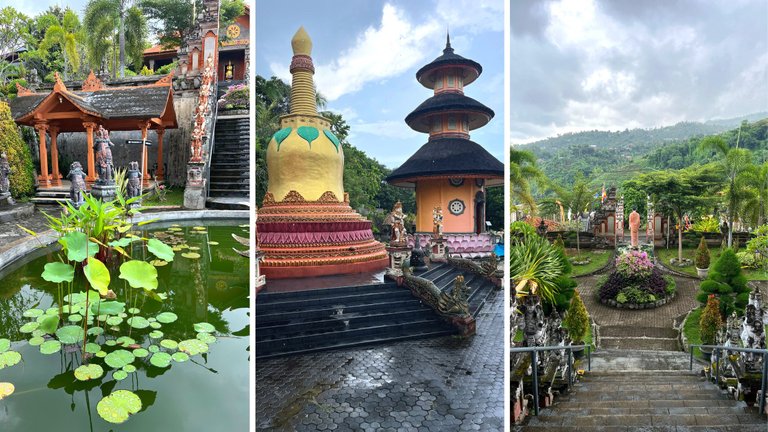
Unlike the majority of temples in Bali that are Hinduist, this one is Buddhist. It’s located on the Northern shore of Bali, close to the popular Lovina beach, famous for its dolphin-watching activities. You are required to wear a sarong as well.
The Brahmavihara temple is unusually colorful compared to other temples in Bali – maybe because it’s of a different religion. It’s pink and orange and black, and also in different shapes and sizes. The individual buildings are located on different levels of a beautiful garden with fountains, beautiful trees and bushes, and many Buddha statues. There are places to pray and meditate, and you are asked to put down your shoes when entering a building.
It is a beautiful place to relax and admire the beautiful architecture. This place is still relatively unknown so you’re probably not gonna be disturbed by crowds of tourists.
4. Tirta Gangga
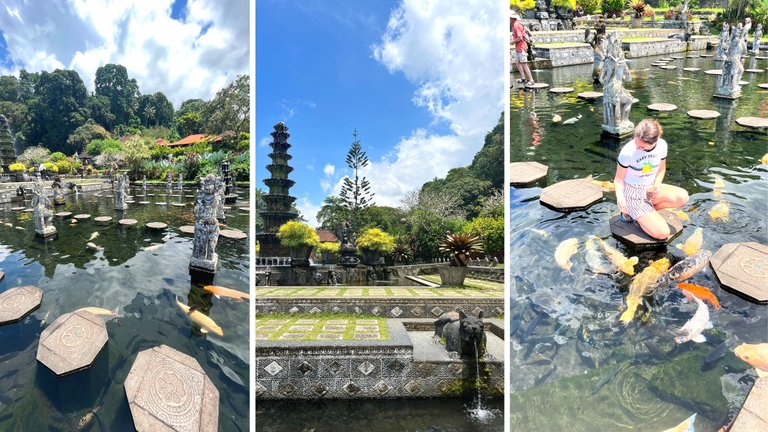
The Instagram-famous temple is located in the east of Bali, and it’s quite touristic, to the extent that you’re not required to wear a sarong. The temple is known for its water elements and ponds filled with beautiful orange Koi carp.
There are plenty of stands where you can buy fish food for very little money, and feeding the fish makes an amazing experience (and also pictures). The most popular part of the temple is at its very front, but if you go further, you will find many more ponds, beautiful flowers, and trees. You can also relax at one of the swing benches or at the yoga hall.
I advise you to come during the weekdays and also in the morning, as the temple tends to get busy in the afternoon.
5. Tanah Lot
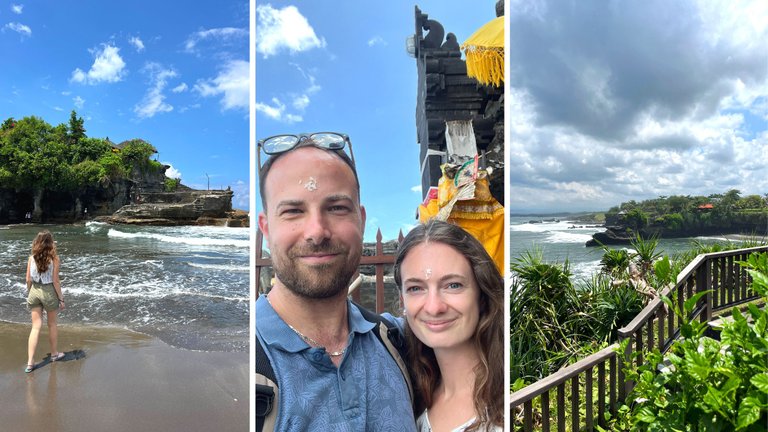
I wasn’t sure whether to include this temple on the list at all. After all the hype I’d heard about the temple, I was simply disappointed (and also in comparison with Brahmavihara-Arama that I visited the previous day). Tanah Lot is a rather small temple located on a cliff in the ocean, accessible only when the tide is low. And it looks beautiful, except for one detail: you cannot access the temple itself. For the entrance fee you pay, you are let into the complex, which is a nice place for having a drink with a view or walking by the shore. But if you’re expecting a temple, it’s not really happening.
Tanah Lot is very touristy and with typically stupid tourist attractions, such as „the holy snake“, which is a local deadly sea snake (don’t worry, he doesn’t have any teeth at this point) that you can see for a donation. The only thing I liked about the temple that made it all up for me was the blessing.
When the tide was low enough to get closer to the cliff on which the temple is built, you could come to a small cave with a water spring. For a small donation (which I didn’t mind here), my partner and I could cleanse ourselves in the spring and then get blessed with rice on our foreheads. That was nice and is probably the reason why I decided to include Tanah Lot in this list after all.
Which of these temples would you want to visit?
THANKS FOR READING!
For more travel content, follow me on Instagram & on PeakD.







